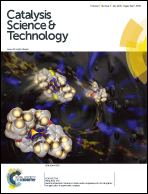Sulfonic acid-functionalized periodic mesoporous organosilicas in esterification and selective acylation reactions†
Abstract
The application of sulfonic acid-functionalized periodic mesoporous organosilicas (PMOs) having either phenyl (1a) or ethyl (1b) bridging groups was investigated in the esterification of a variety of alcohols and fatty acids. It was found that 1b consistently exhibited higher catalytic performance than 1a in the described reaction. In particular, it was proposed that the superior catalytic activity of 1b in esterification of fatty acids with methanol is a result of adequate hydrophobic–hydrophilic surface balance in the ethyl PMO catalyst. In addition, the study of chemoselective acylation of 1,3-butanediol with dodecanoic acid with varied mesoporous silica-supported solid sulfonic acids including both 1a and 1b implies that there is a compromise between the reaction selectivity and the surface physicochemical properties of the employed catalyst. Our results clearly show that the catalyst having high surface hydrophilic nature gives high selectivity toward the formation of mono-acylated products whereas those with relatively high hydrophobic characteristics showed enhanced selectivity toward the formation of di-acylated products.


 Please wait while we load your content...
Please wait while we load your content...